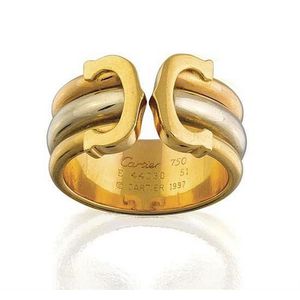Cartier Tri-Colour Gold Crossover Ring, 1996
You must be a subscriber, and be logged in to view price and dealer details.
Subscribe Now to view actual auction price for this item
When you subscribe, you have the option of setting the currency in which to display prices to $Au, $US, $NZ or Stg.
- Bombe Design in Jewellery - In the early 18th century, during the reign of Louis XIV, French court jewellers developed a new style of jewellery called "bombé" because of its bulging, curved shape.
The bombe design can be found in various styles of jewellery, from Georgian, Victorian, Art nouveau, to Art Deco and Retro eras, with the materials and techniques reflecting the era the jewellery was made.
The design is used for rings, bracelets, necklaces and earrings, where a curved or rounded shape is emphasized, giving an organic look to the piece, with the piece often made of gold and set with precious stones, such as diamonds, rubies, emeralds, and sapphires. The bombe design was also paired with other design elements such as engraving, enamelling, or gemstones - Assay / Assayed - Assaying is the testing of a metal, most commonly silver and gold to determine its ingredients and quality. In Britain, once an item of silver or gold has been assayed, a mark is stamped on it, certifying its purity. Known as hallmark, it derives its name from the Guild Hall of the Goldsmiths' Company, who recieved its Charter in 1327 giving it the power to assay and mark articles of gold and silver.
This item has been included into following indexes:
Visually similar items

18ct tri-colour gold 'trinity' ring, Cartier, designed as three entwined 3.55 mm wide bands, the pink band engraved to the front les must de Cartier, size 49 (K1/2), signed Cartier, maker's marks, numbered A1956K.

A gold bracelet, composed of nine interlocking polished yellow gold bangles, mounted in 18 carat yellow gold, gross weight approximately 102.1 grams, inner circumference 23.0 cm

18ct gold 'Double C' ring, Cartier, circa 1997, the tri-colour gold sprung ring is of reeded design terminating in a 'C' motif, size M (51), signed Cartier, numbered E 44030.

A diamond, ruby and sapphire trinity ring, Cartier, signed and numbered 908 475,18ct gold, ring size O, original box. (A gift from Elton John)
